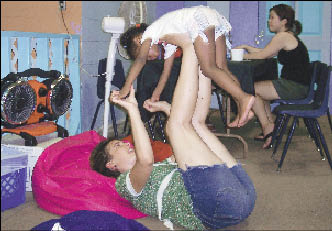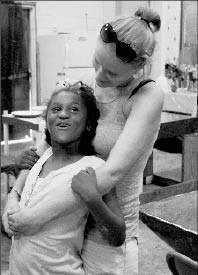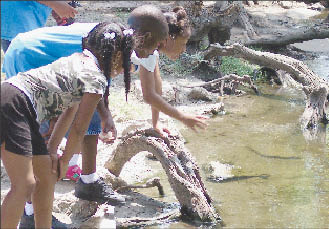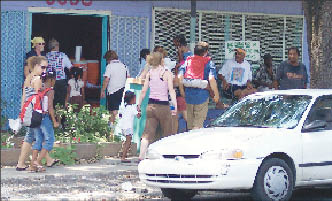New Orleans, La.—If you run a youth program in a poor community, you probably feel that you don’t have enough resources, that there’s too much work, maybe even that conditions are outrageous. To make yourself feel better, meet Cara Rambusch.
The first time I see her, she’s brushing past me on a hunt for a stepladder. She carries it out of a community center, across a junky intersection and down a block to an overgrown field infested with fire ants. There, a few youth workers climb the ladder and drop water balloons to the ground, while kids in her summer camp watch to see if they break.
Around here, that’s a field trip.
 |
|
Cheer Up: Becca Crenshaw, an intern from Hampshire College in Massachusetts, brings some laughter to children at EC’s summer camp in the Lower Ninth Ward. Photo: Photo by Patrick Boyle |
Rambusch, 27, ran what appeared to be the only youth program this summer for the neediest children in the most devastated community in America – the Lower Ninth Ward. The program occupies a corner of a community soup kitchen, wrapped by a white lattice fence that marks off an area as big as a living room. An old school bus sits idle on a side street, because the agency can’t afford a driver, even for one day. The camp staff consists mostly of people like me and my 20-year-old daughter – two of the countless volunteers who drop in to help for a few days, then go home.
We spend five days here in August, helping out at this and two other nonprofits for a volunteer vacation and to get a taste of youth services in the city’s most destitute community, two years after hurricanes Rita and Katrina.
Here I see among the most depressing scenes of my life.
Finding a Youth Camp
Even for a journalist who spent years doing street stories in the downtrodden communities of New York and Washington, entering the Lower Ninth Ward at night stirs discomfort. When I drive our rented economy car over a narrow drawbridge on St. Claude Avenue, I feel like we’ve stumbled into “Night of the Living Dead.” The old version, in black and white.
No matter how much you read or hear about the horrible shape of this city’s poorest communities, in person, the devastation is otherworldly. For miles down St. Claude, a main drag, almost every house and store sits vacant. At 9:30 p.m. we see no open businesses, not even a gas station. Occasionally we spot a pedestrian – why? – and stop at traffic lights for nothing.
I figure that at least the agency we’re going to work for will provide an oasis.
Uh-uh. We pull up to a battered storefront that is the local headquarters of Emergency Communities (EC). Through the gates over the front doors, a man inside yells for us to drive our white Ford Focus around the block to a back alley. There we squeeze past an assortment of vehicles, a Dumpster and a small trailer, park next to an empty house and step out to meet some of the 20-somethings who run EC. Many a youth worker would recognize the cast: friendly, with a smattering of tattoos, body piercings, distinctive hairstyles, and shorts and T-shirts that emit a whiff of being worn a few days in a row.
We’re introduced to Cool Hand Luke, who sports a Mohawk and almost always wears shades, and a uniformed security guard. They walk us across the street to the “church” where the volunteers stay. It’s actually a warehouse that houses a church on one side and a lumber supply company on the other. The guard unlocks the door, which is an iron gate. Luke points to a portable toilet and says that if we have to visit that in the middle of the night, prop open the gate or we’ll be locked out.
We walk in to a dim, unfinished construction zone, mostly wall studs with no walls. My daughter, Alyssa, spots the first rat of the week. In the back of a large open space of the warehouse, some 20 cots sit under canopies of mosquito netting that flutter in the breeze of a half-dozen floor fans. There is no window, no running water.
It’s August, and New Orleans is slogging under what even the locals call a heat wave. Alyssa and I stick an industrial-sized fan at the foot of our cots and try to sleep in the wind.
An Unplanned Youth Program
 |
|
Happy campers: Rambusch and a girl named Ma’Jai in the community center. Photo courtesy of EC |
This is the environment that Rambusch walked into last spring, a few days after graduating from Fordham University in New York with a master’s degree in administrative social work.
The Connecticut native had spent a year teaching preschool in Kentucky on a service mission with the Christian Appalachian Project, and she wanted to help make social programs more effective. She wanted to start in New Orleans.
She found an advertisement on Craigslist for someone to start an after-school program at EC.
EC was created by young adults who came here to volunteer after the hurricanes and grew frustrated by the bureaucratic sloth of official relief organizations like the Red Cross. It was incorporated in October 2005 and is funded largely by the United Way of Greater New Orleans ($700,000 so far) and several other groups. EC collected just over $500,000 last year, says Executive Director Mark Weiner.
Many of the core people here appear to be disconnected youth. When I ask where they’re from, I typically get a smile and a string of city names. Stories about EC have described it as a group of contemporary hippies, or environmentally conscious wanderers used to living off the land.
 |
|
Gone fishin’: Kids from the BBC camp try to catch minnows at a city park. |
That explains why the place feels like a commune. Out the back door of the community center is an encampment with a kitchen behind a tarp, a refrigerated trailer, an outdoor shower and toilet, a compost pile, a laundry line that’s always sagging with towels, and a large trailer where about 20 EC regulars sleep.
All but three of the workers here are volunteers, Weiner says.
EC has set up camps at several Katrina area sites, including one of the post-Katrina trailer parks, where it ran after-school programs.
The organization did not set out to run youth programs when it took over this old community center in January. Using space donated by the nondenominational Light City Church – the church in the warehouse across the street – it planned to feed the locals three meals a day, gut and renovate homes, and cut down overgrown lawns (which can draw heavy city fines).
Soon after the “Goin’ Home Café” opened, however, kids began hanging around both inside and out. “Almost immediately, we became a sort of default after-school program for this neighborhood,” Weiner says. “There were a lot of unsupervised children.”
If there was a youth program in the Lower Ninth, no one knew about it. No YMCA, no Boys & Girls Club. I figure I’m missing something, but Gina Warner, executive director of the Greater New Orleans Afterschool Partnership, assures me, “There is nothing.”
One reason is that the ward remains one of the most sparsely populated and least recovered sections of the city, for reasons of race, politics and economics. The vast majority of the houses remain empty; an occupied home is an exception to be noted out loud as we walk down the middle of the streets each day.
To be sure, there are programs in the city doing wonderful things for kids – such as The Youth Empowerment Project, which provides tutoring and other services for adjudicated and at-risk kids. Alyssa and I help there for a few hours one night.
But throughout the city, children face a dearth of offerings. Before the storms, Warner says, the partnership included more than 200 after-school programs sites. This summer, it was 64. Most of the city parks have not reopened.
EC decided to create a youth program and got $12,000 from the Unified Summer Grant fund, a collaborative of the partnership, the United Way, Save the Children and the Emeril Lagasse Foundation. The fund provided $1.6 million to 64 youth programs, Warner says.
Rambusch did her job interviews with EC by phone and came down in late May. Like Alyssa and me, she wasn’t quite prepared for what she would find.
Getting Started
EC was renovating the inside of the community center when Rambusch arrived. “The tables were dismantled; couches were all over the place,” she recalls.
She walked into the center’s large main room, which resembles a cafeteria and is where meals are served each day. “They just pointed to a corner and said, ‘This is where the kids are going to be.’ I was like, ‘What?’ ”
They told Rambusch to expect 50 children a day.
She was later led across the street to her sleeping quarters: the warehouse. She says she was the only resident, except for a long-distance couple who were in a tent getting reacquainted with each other.
The next night, she was promoted to the trailer and assigned one of the 20-plus mattresses. Soon she got an apartment.
And soon she had her corner of the cafeteria looking like a children’s space, decorated with bright paint, artwork and carpeting. She had plenty of supplies to get started, thanks to donations of toys, books and $400 in gift cards.
“People found out we were having a children’s program. Cars would open up and people would come out with all this stuff they had bought us,” she says. Over the ensuing months, visiting volunteers have donated more supplies.
Rambusch was lucky to get what she needed. In their well-intentioned rush to help New Orleans, people from around the country have donated what they thought youth programs here should have, which isn’t always what the programs want. Program managers have had to find ways to manage the donor-driven charity.
“All of these people who sent us books and toys and games,” Warner says. “I’ve had programs tell me, ‘Please tell people not to send any more books. We don’t even have shelves.’ … If you could have sent me Wal-Mart gift cards, I could have done so much more.”
Free crayons, however, cannot overcome the obstacles that youth programs throughout the area face to varying degrees: the mental state of the children, the scandalous shortage of resources, and managing a revolving door of volunteers.
Grappling with Emotions
 |
|
A hot property: After playing in a parking lot for an hour, children and youth workers head back to EC’s soup kitchen and summer camp – which offers little respite from the heat. Photo courtesy of EC |
Depression.
That’s my first feeling when Alyssa and I walk into the cafeteria and see the “summer camp”: Kids squeezed into a corner of a soup kitchen, spending all day playing boxed games or watching movies on a huge TV, stuck inside, next to an industrial-strength oscillating fan.
For our first two days, we observe this from outside the white lattice fence, as EC needed us to cut overgrown lawns – which means sawing down five-foot-high weeds – and power-wash the mold off a house. By the time we finish our Wednesday at this camp and Thursday at another, my depression was coupled with admiration for what youth workers accomplish under horrible conditions, and anger that they have to.
As soon as children began arriving early in the summer – 25 to 35 on most days – the mental and emotional struggles that have befallen the “Katrina kids” were on display. Screenings of local youth by Louisiana State University’s Health Sciences Center have found more than 30 percent showing symptoms of depression or post-traumatic stress. In a survey of area parents by the National Center for Disaster Preparedness at Columbia University, half said their children had emotional and behavioral problems they didn’t have before the storm. New Orleans schools have reported far more disciplinary problems than before, mostly involving aggression and defiance.
As is typical of under-resourced youth work, Rambusch and her semi-permanent staff – several interns and AmeriCorps workers – got these issues dumped on them and figured out how to respond. Fights would erupt over little things during seemingly peaceful games. “It would just be a spark, and the kids would be at each other’s throats,” Rambusch says. “These are the kinds of kids who really will hit each other.”
A few youths were banned, including a 9-year-old found with a knife.
Even during our brief stay, we could see defiance and testing by some kids. It was clear that many of them were getting little structure and guidance at home – hardly surprising, considering the living conditions.
Fortunately, Rambusch – who’s a trim 5 feet 7 inches and moves around so much that I never got her picture – wasn’t afraid to jump into the middle of two brawling boys. “It did change the way the kids looked at me,” she says. “I am the boss. Yes, I can break up fights.”
Getting Out
The most frustrating image here is the school bus.
Summer camps routinely take their children on field trips – to a pool during a heat wave, for instance – and there may be no camp in America where the kids are more in need of a field trip. The plan at EC was for up to three a week, including treks to the city pools.
But the bus needed some work and someone licensed to drive it. Rambusch says that when an EC person suggested she drive, “I was like, ‘No! Hold up!’ ” There was no way, she says, that she was going to be in charge of the children while driving them in a school bus.
But EC could not afford to hire a driver. So in a city with a first-rate aquarium, a minor league baseball team and a couple of decent parks, where the adult entertainment includes a downtown casino, topless clubs on Bourbon Street and an annual event called the Red Dress Race – in which we saw men in red dresses running from bar to bar to drink – the children of the Lower Ninth travel to play in a field that, Rambusch says, is “covered with fire ants.”
The field sits next to the warehouse where we sleep, and it’s there that the staffers climb the ladder to drop water balloons on contraptions the children constructed – from milk crates, newspapers and plastic bags – to stop the balloons from breaking.
On the other side of the building is a parking lot – the youths’ other outdoor recreation area. We take them there for an hour to jump rope, toss a football and fall off a pogo stick-like toy that no one can figure out.
Twirling one end of a jump rope in the New Orleans sun gets old fast. The volunteers take occasional breaks in a slice of shade against the building and sip water from a cooler lugged over from the kitchen. Like most of the water at EC, this batch is lukewarm and tastes like coffee, because that’s what goes in the coolers at breakfast.
Others have tried to do more.
“I had a guy come down who wanted to start his own sports camp,” Rambusch says. She told the man his well-intentioned idea was impossible for various reasons: not enough kids of the same age and skill level, not enough volunteers, too many bugs, overwhelming heat, the need to lug coolers of water to the field, “and there’s nowhere to play unless you have a weed whacker and can mow the lawn yourself.”
While we’re at EC, two visitors do arrive with practical donations and plans: an elderly couple from Canada with disposable cameras to give to each child, as part of a photo project in which the kids are going to document their lives, and a woman with a load of art supplies and projects that occupy a nice chunk of an afternoon.
The kids play with their construction paper and glue paint in the cafeteria, which is theirs to use during the daily gap between lunch and dinner. Rambusch says she sometimes pushes aside the tables and plays Wiffle Ball there. She’ll approach the volunteers and staff hanging out behind the building at night and say, “Tomorrow we’re playing Wiffle Ball. Everyone who’s free, I need you in this room.”
The kids “loved it.”
Managing Volunteers
“The volunteer turnover is insane,” Rambusch says.
The U.S. Corporation for National and Community Service reported this summer that 1.1 million people have volunteered to help in the areas affected by Katrina. Agency staffers here are quick to say how much they appreciate any help they get, and they show it. But the constant flow of short-time volunteers to New Orleans creates issues.
For the kids, the problem is the revolving door of adults who don’t stick with them. Like Alyssa and me.
“To just be in and out, that’s kind of hard on kids,” Warner says. “These kids have had so many changes and upheaval in their lives.”
It also makes work for people like Rambusch, who just about every day this summer had to find jobs for new volunteers and keep an eye on them. Warner’s after-school network tries to find places to send out-of-towners who want to help for a few days. “Especially during spring break – we were overwhelmed,” she says.
There is no way to run background checks on everyone who comes down to work for a week or two. No one did any checks on us.
Rambusch says that while the vast majority of volunteers were great, she had to “kick out” a couple. “One went off on a child,” she says, scolding a girl to “be thankful she’s there, because she’s a volunteer.”
Where’s the Help?
Conditions are moderately better at our next camp, but the struggles are still surprising – like having to keep the youths out of the building during its last week for fear that a city inspector would shut it down.
Not all agencies are in dire straights. A YMCA in neighboring Jefferson Parish was doing quite well. Both agencies are described elsewhere on these pages.
What’s most striking is how sparse the offerings are for the area’s poorest youth. Service providers complain that foundations have visited to collect information for reports about the area, but have provided far too little money – in some case, none – for youth services.
“Where are the private foundations?” Warner says. “You can put out all these public policy reports, but you have kids who are suffering down here.”
The conditions were summed up best by the title of a report issued in August by the Children’s Defense Fund: “Katrina’s Children: Still Waiting.”
Contact: Emergency Communities (917) 442-8900, http://www.emergencycommunities.org; Greater New Orleans Afterschool Partnership (504) 304-8265, http://www.gnoafterschool.org.





























